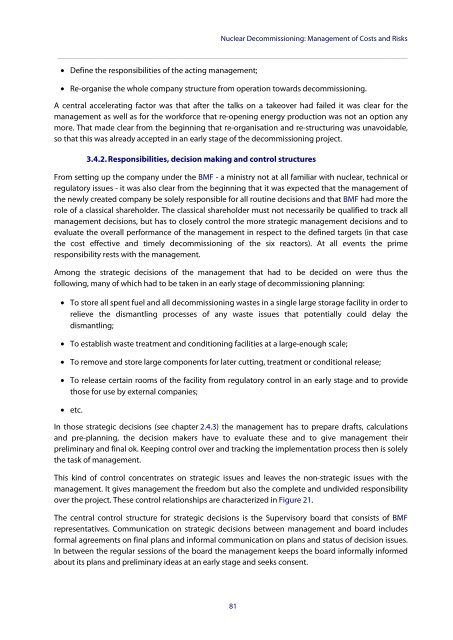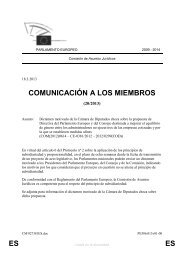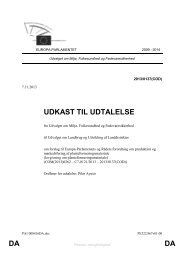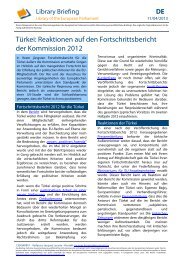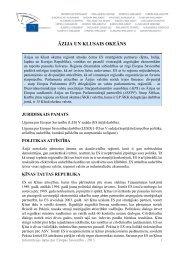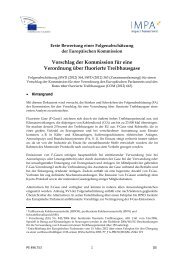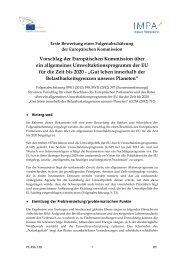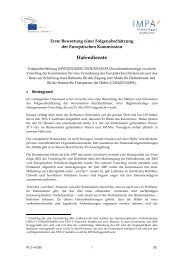Link to the study - European Parliament - Europa
Link to the study - European Parliament - Europa
Link to the study - European Parliament - Europa
Create successful ePaper yourself
Turn your PDF publications into a flip-book with our unique Google optimized e-Paper software.
Nuclear Decommissioning: Management of Costs and Risks<br />
____________________________________________________________________________________________<br />
Define <strong>the</strong> responsibilities of <strong>the</strong> acting management;<br />
Re-organise <strong>the</strong> whole company structure from operation <strong>to</strong>wards decommissioning.<br />
A central accelerating fac<strong>to</strong>r was that after <strong>the</strong> talks on a takeover had failed it was clear for <strong>the</strong><br />
management as well as for <strong>the</strong> workforce that re-opening energy production was not an option any<br />
more. That made clear from <strong>the</strong> beginning that re-organisation and re-structuring was unavoidable,<br />
so that this was already accepted in an early stage of <strong>the</strong> decommissioning project.<br />
3.4.2. Responsibilities, decision making and control structures<br />
From setting up <strong>the</strong> company under <strong>the</strong> BMF - a ministry not at all familiar with nuclear, technical or<br />
regula<strong>to</strong>ry issues - it was also clear from <strong>the</strong> beginning that it was expected that <strong>the</strong> management of<br />
<strong>the</strong> newly created company be solely responsible for all routine decisions and that BMF had more <strong>the</strong><br />
role of a classical shareholder. The classical shareholder must not necessarily be qualified <strong>to</strong> track all<br />
management decisions, but has <strong>to</strong> closely control <strong>the</strong> more strategic management decisions and <strong>to</strong><br />
evaluate <strong>the</strong> overall performance of <strong>the</strong> management in respect <strong>to</strong> <strong>the</strong> defined targets (in that case<br />
<strong>the</strong> cost effective and timely decommissioning of <strong>the</strong> six reac<strong>to</strong>rs). At all events <strong>the</strong> prime<br />
responsibility rests with <strong>the</strong> management.<br />
Among <strong>the</strong> strategic decisions of <strong>the</strong> management that had <strong>to</strong> be decided on were thus <strong>the</strong><br />
following, many of which had <strong>to</strong> be taken in an early stage of decommissioning planning:<br />
To s<strong>to</strong>re all spent fuel and all decommissioning wastes in a single large s<strong>to</strong>rage facility in order <strong>to</strong><br />
relieve <strong>the</strong> dismantling processes of any waste issues that potentially could delay <strong>the</strong><br />
dismantling;<br />
To establish waste treatment and conditioning facilities at a large-enough scale;<br />
To remove and s<strong>to</strong>re large components for later cutting, treatment or conditional release;<br />
To release certain rooms of <strong>the</strong> facility from regula<strong>to</strong>ry control in an early stage and <strong>to</strong> provide<br />
those for use by external companies;<br />
etc.<br />
In those strategic decisions (see chapter 2.4.3) <strong>the</strong> management has <strong>to</strong> prepare drafts, calculations<br />
and pre-planning, <strong>the</strong> decision makers have <strong>to</strong> evaluate <strong>the</strong>se and <strong>to</strong> give management <strong>the</strong>ir<br />
preliminary and final ok. Keeping control over and tracking <strong>the</strong> implementation process <strong>the</strong>n is solely<br />
<strong>the</strong> task of management.<br />
This kind of control concentrates on strategic issues and leaves <strong>the</strong> non-strategic issues with <strong>the</strong><br />
management. It gives management <strong>the</strong> freedom but also <strong>the</strong> complete and undivided responsibility<br />
over <strong>the</strong> project. These control relationships are characterized in Figure 21.<br />
The central control structure for strategic decisions is <strong>the</strong> Supervisory board that consists of BMF<br />
representatives. Communication on strategic decisions between management and board includes<br />
formal agreements on final plans and informal communication on plans and status of decision issues.<br />
In between <strong>the</strong> regular sessions of <strong>the</strong> board <strong>the</strong> management keeps <strong>the</strong> board informally informed<br />
about its plans and preliminary ideas at an early stage and seeks consent.<br />
81


